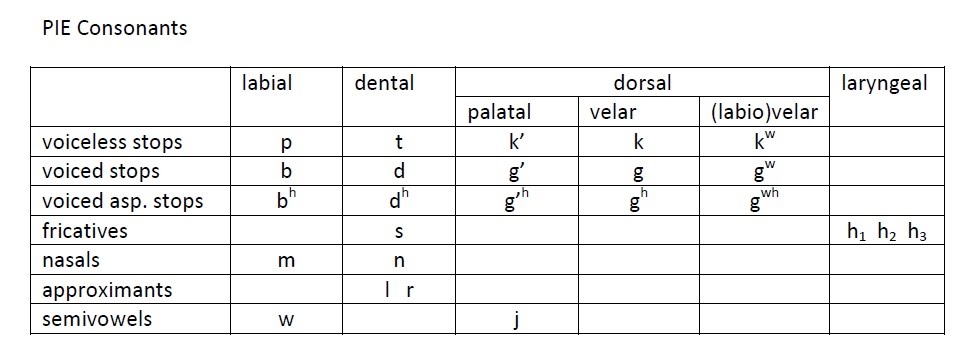Consonants
Modern English has the following consonant phonemes:
One of the questions for the historical study of English is where and how these phonemes originated. To start that process, examine the set of consonant phonemes in PIE:

The charts are quite similar in some aspects, though there are some major differences. Both PIE and Modern English have the set of voiceless and voiced stops /p/ /t/ /k/ and /b/ /d/ /g/, but PIE divides its velar stops into three distinct types. Instead of a simply /k/ for instance, there is a palatalized /k'/, a standard velar /k/, and then a labiovelar /kw/. The first of these is similar to the type of /k/ that we would pronounce in the words leak or king, where the velar /k/ is what we would pronounce in the words lock or kong. The labiovelar is a /k/ with rounded lips, similar to our "q" sound as in queen.
A further difference between PIE and Modern English consonant phonemes is that PIE has a set of voiced aspirated stops: /bh/, /dh/, /gh/. These are similar to /b/, /d/, and /g/, but with a heavy breath of air. In Modern English the voiceless stops /p/ /t/ and /k/ are aspirated at the beginning of a stressed syllable, but this aspiration is not phonemic; on the other hand, Modern English voiced stops /b/ /d/ and /g/ are not aspirated. In PIE, voiced stops were phonemically distinguished into aspirated and non-aspirated varieties. To approximate the voiced varieties, try saying the words abhor or adhere.
Finally, a number of Modern English phonemes do not occur. PIE only has one fricative, /s/, and there are only two nasal phonemes, /m/ and /n/; /ŋ/ does not appear.
Laryngeals
The last set of sounds to discuss in the consonant set are the so-called laryngeals, a set of sounds that sometimes acted as vowels, sometimes as consonants. They were first proposed by Ferdinand de Saussure in a paper he wrote (when he was 21!) to explain some idiosyncrasies in the Greek phonetic system. To put it extremely simply, Saussure showed using the comparative method that there were some sounds in Greek words that should have been different sounds if all the proper developments of sound laws were followed. He hypothesized that the reason the "wrong" sounds appeared in a few places in Greek could be explained by assuming that there must have been other sounds in PIE that had entirely disappeared but had affected the sound changes before they disappeared. It was difficult for him to prove the existence of something that had completely disappeared, and therefore many people did not accept his theory when it first appeared. Several decades later, however, some clay tablets were excavated in Turkey written in a previously unknown language around the 16th century BCE. The language, which scholars named Hittite, was eventually deciphered and recognized an Indo-European language. In fact, it is the earliest Indo-European language that was ever written down. As the language was documented, linguists realized that it contained sounds which corresponded exactly to the laryngeals Saussure had proposed and which occurred in the same places where he said they should! They are written today as h1, h2 and h3. It is not entirely clear what the distinctions between these were, and the details are not necessary to go into here. Simply put, these sounds disappear in almost all PIE languages (except for the Anatolian branch), but they do leave traces. The h1 laryngeal is a neutral one and has no effect on the vowel around it. The h2 laryngeal has an “a-coloring" to it. This is why we used it when we reconstructed the PIE word for father, *ph2ter-. PIE only had an /e/ and an /o/ vowel, and so the /a/ vowel in the words for father must have come from the h2 laryngeal. Finally, the h3 laryngeal probably included lip rounding as well, since it often led to an /o/ type vowel.
The laryngeals disappear in Germanic and so we will not discuss them in any more detail.
Vowels
There are major differences in the vowels of PIE compared to Modern English. Modern English has a set of five front vowels, some tense and some lax, one central vowel, and six back vowels, again tense and lax varieties. According to some scholars, PIE in its earliest stages only had one vowel /e/. Most scholars, however, find it easier to work with the notion of two vowels: /e/ and /o/, each of which could occur in long and short varieties, making four vowel phonemes total: /e/, /ē/, /o/, /ō/. Note that these are both mid vowels, differing from each other in frontness and in roundness of the lips. Note also that in PIE vowel length was a phonemic difference.
We can add to these four vowels the two semivowels /w/ and /j/. When these appear in an environment in which there is no other vowel, they convert to the appropriate vowel /u/ and /j/. Thus, the root *wed- (which we will discuss in the section on morphemes) has a version in which there is no /e/ vowel. It would appear as *wd-, but this is unpronounceable, and so the /w/ converts to its corresponding vowel, /u/, giving us *ud-.
Although not classified as true vowels, the resonant sounds (i.e., /r/, /l/, /m/, /n/) could appear as the nucleus of a syllable as well. This is similar to a Modern English word like bottle, where the final /l/ acts as a syllable to itself, in the same way a vowel would. In other words, to pronounce that word, we do not say [bɑtəl] but rather [bɑtḷ]. The dot underneath the [ḷ] signifies that it is acting as the nucleus of a syllable in the way that vowels normally do. We do the same with nasals in English, such as in the words bottom or button.

